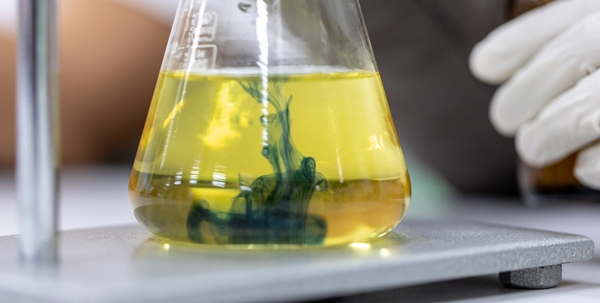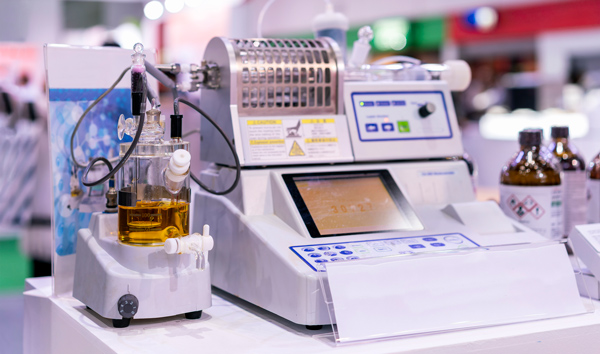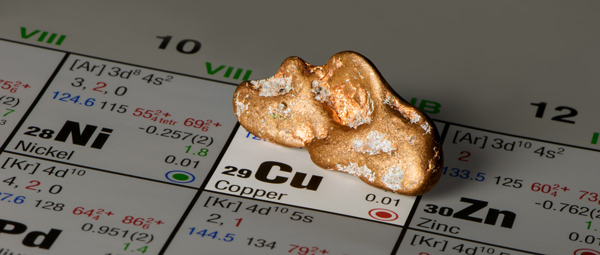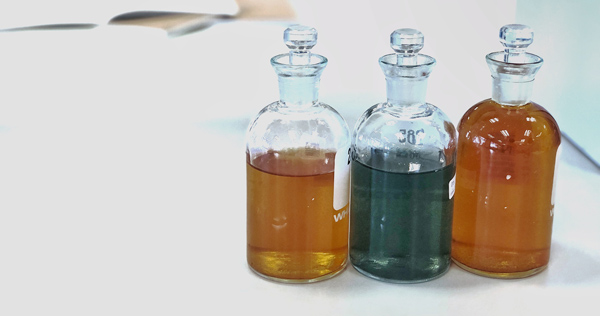Beyond Acid-Base: Other Titration Types
When we think of titrations, we often think of the classic acid-base titration. However, many chemists rely on other types of titrations for their day-to-work. In this blog, we’ll go beyond acid-base titration and explore other methods.
Amperometric Titration
In an amperometric titration, the experimenter measures the current between the titrant and the probe, which is set at a certain potential to drive an electrochemical change. The current, or electron flow, depends on the concentration of the analyte. As the titration progresses, the analyte of interest is reduced, and the current flow decreases until the analyte cannot be reduced any further. Beyond this point, the current flow depends on the electrochemical reactivity of the titrant.
Amperometric titrations have many applications, including determining the concentration of a specific substance in a sample, analyzing complex mixtures in which one ion is selectively reactive with the titrant, and investigating the kinetics of chemical reactions. Often, amperometric titrations are used because they can be performed quickly and accurately despite variables in solubility or solution dilution.
Amperometric titrations are commonly used to determine the levels of chloride (Cl-) in human blood, as chloride is an important electrolyte that helps maintain the balance of fluids in the body. Abnormal chloride levels indicate various health conditions such as dehydration, kidney disease, or respiratory alkalosis. In amperometric titrations for chloride analysis, a clinical laboratory scientist or medical laboratory technologist immerses a silver-silver chloride electrode in a blood sample and adds the titrant until the endpoint is reached. They measure the change in current which allows them to calculate the concentration of chloride in the sample.
Conductometric Titration
Similar to amperometric titration, conductometric titration also measures changes in the electrical conductivity of a solution as an analyte is added. The primary difference between the two is the physical property being measured. Amperometric titrations measure the current produced by an electrochemical reaction between the detection probe and analyte as a titrant acts to reduce the analyte concentration, while conductometric titrations measure the change in total number of ions (the electrical conductivity) in the solution.
Conductometric titration is commonly used to analyze acids, bases, and salts. These types of titrations are highly sensitive, accurate, and change the ion concentration in solution in predictable ways. However, factors such as temperature and electrode drift can affect ion mobility in solution and skew measurements.

'
Conductometric titrations are used to determine concentrations of acidic or alkaline pollutants for officials monitoring the scale of substances that affect public health and the environment. Conductometric titration monitors the change in electrical conductivity as an acidic or basic titrant is added to the sample. Plotting the conductivity against the volume of titrant generates a conductometric titration curve. A change in slope of the curve indicates the endpoint of the titration. This can be used to calculate the concentration of the analyte based on the volume and concentration of the titrant used.
Teaching Tools: Wireless Conductivity Sensor
Measure conductivity and total dissolved solids in aqueous solutions with the Wireless Conductivity Sensor! Perform conductometric titrations, investigate water quality, and more - all with an improved range and decreased error.

| Learn More |
Iodometric Titration
Iodometric titration involves the use of iodine as a titrant to determine the concentration of an analyte. Iodine is a strong oxidizing agent and widely reactive, making it an ideal titrant for a range of analytes. In this technique, we add iodine to the analyte, causing a reaction between the two to form a compound. We reach the endpoint of the titration when all of the analyte has reacted with the iodine, and then detect any excess iodine by adding a starch indicator that turns the solution blue-black.

Iodometric titrations are useful to analyze oxidizing agents, reducing agents, metal ions, or organic compounds containing unsaturated (double or triple) bonds. For instance, in the pharmaceutical industry, iodometric titration is used to determine the potency of drugs containing oxidizing agents such as hydrogen peroxide or sodium hypochlorite. In the food industry, they’re used to measure the amount of ascorbic acid, or Vitamin C, in foods and beverages.
Iodometric titrations are accurate and inexpensive to perform, but they require careful control of the pH and temperature throughout the titration.
Coulometric Titration
Coulometric titrations utilize an electrochemical cell to generate a titrant; the amount of titrant generated is proportional to the quantity of the analyte in the sample. The electrochemical oxidation or reduction of a substance in the cell is what makes this technique highly accurate, as it uses electricity to measure the analyte rather than another parameter, such as volume. We reach the titrant endpoint when we react all of the analyte with the titrant, allowing us more control of the titrant concentration during the titration.

It may help to compare coulometric titrations to volumetric titrations. The main difference between the two is the way the titrant is added to the analyte. In a volumetric titration, we add a fixed volume of titrant from equipment like a burette to the analyte until the endpoint is reached, whereas in coulometric titrations, the titrant is generated within the electrochemical cell. In other words, the precursor titrant is added in excess to the analyte rather than pre-prepared as in volumetric titrations.
Coulometric titration is widely used in industry and research to analyze organic compounds, pharmaceuticals, and even metals. Coulometric titration is also used to analyze drugs and their impurities by generating titrant from the oxidation of the drug in the cell.

Another application is for the analysis of metals and metalloids, such as copper, arsenic, and mercury, since coulometry can detect and quantify trace amounts of metals present in a sample. In this technique, we generate a titrant in the electrochemical cell by the controlled oxidation or reduction of a metal ion. We then add the generated titrant to the sample until all the metal ions have reacted, determined by a change in the cell potential. Then, we can calculate the amount of metal in the sample based on the current flow needed to create the amount of titrant generated.
Precipitation Titration
In this technique, we add the titrant to the analyte, causing the formation of an insoluble precipitate. The conductivity will decrease until all the analyte metal ions have fallen out of solution, indicating the endpoint of the reaction. Once conductivity stops decreasing, the titration can stop.
Precipitation reactions are useful to analyze halides, sulfates, and phosphates, which all form precipitates. For example, when we add silver nitrate titrant to a sample containing chloride ions, silver chloride precipitates out of solution, indicating that all the chloride ions have reacted with the analyte. Similarly, when we add barium chloride titrant to a sample containing sulfate ions, barium sulfate precipitates out of solution. Conductivity will reach a low point, indicating that all the sulfate ions have reacted with the barium chloride.

Precipitation titrations are common in water, food, and pharmaceutical industries. In the water treatment industry, precipitation titration is used to determine the concentration of ions like calcium, magnesium, and sulfate, which can cause scaling and corrosion in water distribution systems. In the food industry, these titrations are used to measure the concentration of salts and other additives in food products. In pharmaceutical research, precipitation titrations help with quality control to ensure the purity of drugs. Precipitation titration is even used in soil analysis to quantify the levels of essential nutrients like phosphorus.
Precipitation titrations are precise when done correctly, as they require careful control of pH, temperature, and other variables.
Potentiometric Titration
Potentiometric titrations measure the potential difference between two electrodes in a solution as we add titrant to the analyte. A potentiometer is an electronic instrument that measures the potential difference between two points in an electrical circuit.
When a metal ion reacts with the titrant, its charge changes as the two bond. Once all the metal ions react, a sudden change occurs in the potential difference between the two electrodes. This sudden change in the potential difference signals the endpoint of the reaction.

Potentiometric titration is used to analyze samples like wastewater, food, pharmaceuticals, and biological fluid samples. It’s particularly useful in cases where the endpoint of the titration cannot be detected by visual or chemical means.
For information on redox titrations, check out our blog, Redox Reactions & Redox Titrations.

